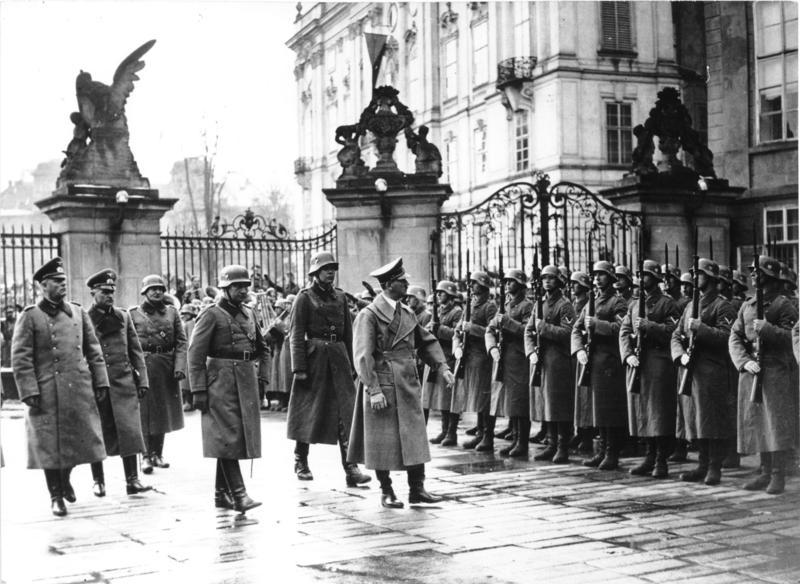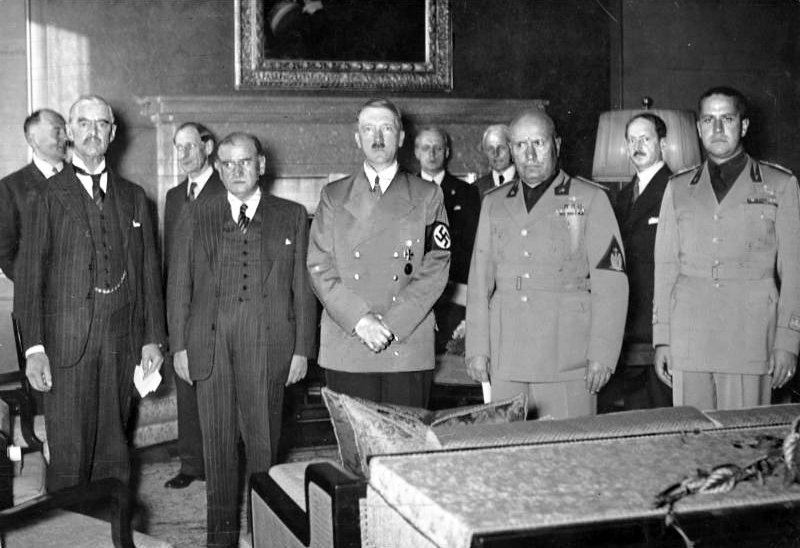HITLER’S INVASION OF CZECHOSLOVAKIA 15 March, 1939
There was a time during the period of the Second World War when Czechoslovakia ceased to exist as a nation. Abandoned by its allies, and left to fend for itself against the onslaught of Nazi Germany, Czechoslovakia was systematically dismembered over the course of late 1938 when it was forced to cede territory to Hitler, and then subsequently occupied by the German military in March of 1939. The process of dismantling the nation was completed at that time by splitting off Slovakia into a nominally “sovereign” puppet state, and then Hitler consolidated what was left over into the Reich Protectorate of Bohemia-Moravia. Czechoslovakia did not re-emerge as an independent nation again until the close of the war in Europe in May of 1945. Read on, and let’s take a closer look at how this all unfolded.
If you are planning a trip to Prague, be sure to join us for our WW2 Tour to see the city’s fascinating historical sites. During this 2.5-hour tour, you will get a glimpse into one of the most turbulent periods in Prague’s history. You will learn why Czechoslovakia was such an important piece on Hitler’s chessboard, and why he decided to take control of the country even before World War II officially began on September 1st, 1939. Whether you are traveling for pleasure or business, this tour is a must-see experience that will help you better understand the city’s history and culture. So what are you waiting for? Book your spot today!

Hitler entering Prague Castle, 15 March, 1939. Photo courtesy of the German Federal Archives, Bundesarchiv, Bild 183-2004-1202-505 / CC-BY-SA 3.0
All throughout the 1930s, Adolf Hitler had had his covetous eye on the lands, people, and industry of young Czechoslovakia, a country which had only been founded just a few scant years before, when the Austrian Empire had fallen into ruins at the end of First World War. During the 1920s, Czechoslovakia had then become one of the most industrially advanced and politically progressive states in all of Europe. Hitler wanted that heavy industrial power for the German Reich, and so his expansionist plans had had Czechoslovakia as their first target of takeover since at least 1937, when he had first ordered his generals to draw up plans for a possible future military invasion.
In order to set the stage for a takeover that would provoke the least amount of international outcry, Hitler staged one of the most devious pieces of political theater of the 20th century. Czechoslovakia was an ethnically diverse nation which, in addition to the majority Czech and Slovak populations, also contained within its borders large amounts of German (3 millions), Polish, and Hungarian citizens, among others. Along Czechoslovakia’s northern frontier was a predominantly German-speaking region known as the Sudetenland. Hitler secretly collaborated with Karl Henlein, leader of the Sudeten German Party or SDP, and by 1935 the party was being covertly funded by the German Foreign Office. The SDP did everything in its power to instigate German nationalistic sentiment among the German-speaking peoples of Czechoslovakia, and started a massive propaganda campaign which aimed to show that the German minority was being repressed by the predominantly Czech government. Feigning outrage over the supposed mistreatment of German peoples inside the borders of his southern neighbor, in September 1938 Hitler demanded that Czechoslovakia cede the Sudetenland to Germany or be prepared to face war.
At that time, Czechoslovakia had standing mutual protection alliances with both France and the Soviet Union. However, the agreement with the USSR required that it come to Czechoslovakia’s defense only in the case that France did so also. The French government, in spite of its treaty agreements, had no desire to be drawn into a war with Germany, and neither did Great Britain which would have been obligated to aid France if war broke out on the continent. British Prime Minister Neville Chamberlain, anxious to avoid war with Germany at any cost, visited Hitler at Obersalzberg on 21 September, and assured him that his aims in Czechoslovakia could be achieved peacefully.
On September 29, 1938, Hitler agreed to receive Chamberlain, French Premier Eduoard Daladier, and Italian dictator Benito Mussolini in Munich, and the resultant Munich Agreement awarded large chunks of Czech territory to the Third Reich. It was finalized while the Czech representatives were forced to wait on a bench outside the meeting room while the fate of their country was decided without their participation in the discussions. The final result of Munich was that Czechoslovak President Edvard Beneš was forced into accepting the proposal to cede the Sudetenland to Germany by 10 October, believing that Czechoslovakia had no chance of defeating Germany in an armed conflict without the help of its allies. As a protest the president of Czechoslovakia, Edvard Benes, left to the exile in England. The Soviet Union was largely ignored during this process.

Chamberlain, Daladier, Hitler, and Mussolini shortly after the conclusion of the Munich Agreement. Photo courtesy of the German Federal Archive, Bundesarchiv, Bild 183-R69173 / CC-BY-SA 3.0
With the loss of the Sudetenland, Czechoslovakia also lost the backbone of its northern defenses, the series of mountain fortifications and bunkers that had been built along the German border during the 1920s and ’30s. And the dismemberment of the state wasn’t over yet, as Czechoslovakia’s other neighbors sought to peel away slices for themselves . Shortly after the occupation of the Sudetenland by Germany, Poland sent troops to annex the region of Teschen which had been disputed since the end of the First World War, and then Hungary was granted huge swaths of Slovak and Ruthenian territory by the Vienna Award of 2 November.
Taking advantage of the greatly weakened state of the Czechoslovak governement, Slovak Populist leader Jozef Tiso was secretly encouraged by Hitler to agitate for Slovak independence. And on 14 March, 1939, Slovak parliamentarians voted in favor of complete succession from Czechoslovakia, and Tiso pubicly “pleaded” with Hitler to step in and take charge of the defense of the newly emancipated Slovakia which duly became Germany’s puppet state. Not that many people know that the Czechs and Slovaks “divorced” twice in the history… second time it was on January 1st 1993 when Czechoslovakia split in the Czech Republic and the Slovak Republic.
Beneš had resigned the presidency of Czechoslovakia and fled into exile shortly before the occupation of the Sudetenland months before, and the new President Emil Hácha was completely out of his depth in dealing with Hitler’s strong-arm tactics. Hácha requested an audience with Hitler upon the announcement of the secession of Slovakia, and during the course of many hours’ worth of overnight meetings, the German dictator was able to browbeat and intimidate the flustered Czech president into agreeing with the German takeover of the rump state and into its incorporatation into the German Protectorate of Bohemia-Moravia in order to supposedly safeguard the peace and security of Central Europe. The agreement was signed at almost 4:00 a.m. on the morning of 15 March, and scarcely two hours later German troops began pouring over the border into Bohemia and Moravia and took possession of the country while the Czech military was commanded to step down and allow them to enter. That evening Hitler made his triumphant entry into Prague where he proclaimed his bloodless victory at Prague Castle, and Czechoslovakia ceased to exist for the next 6 years.
Did you ever wonder why Prague was not heavily bombed such as the other European cities or what was Hitlers’ evil plans for the Czechs? Join us for the WW2 Tour in Prague and together with your local guide you’ll uncover the hidden details in the streets and you will learn about heroic deeds and tragic losses of the Czech nation, reveal the disturbing past of the Czech capital during WW2!

Hello, Jeff! Thank you for your article, very interesting and well done. I’m interested if you know anything about Hitler’s idea to make Prague a capital city of his new impair?
Thank you.
And what was the fate of the Czech army after natzi Germany took control of the Czech Repuplic?
Who came up with idea of Hitler wanting Prague as capital city of his 1000 year Reich? He had huge plans for rebuilding Berlin into the mega-city to be called Germania. When considering to level Paris to the ground, he relented, saying that when he will be finished with Berlin, Paris will look like a shadow in comparison.
I am in the process of preparing a one- or two-day seminar on Bedrich Smetana as a Czech patriot, focusing on a detailed analysis of “Ma Vlast.” With so much of Smetana’s music on CDs now in my personal collection, I have become concerned by the absence of proper recognition of Vaclav Talich, the talented conductor of the Czech Philharmonic Orchestra at the time of the NAZI invasion. It was Talich who initiated the first Prague Spring Festival in May 1939, with performances of Ma Vlast and Slavonic dances by Dvorak. And it was Talich who conducted Ma Vlast with NAZIS in the audience on June 5, 1939, which was recorded on a Philips-Miller machine via telephone lines from Prague to Oslo. I have that recording, recently released by the Czech Philharmonic. Why do I not find his name anywhere, and why is Kubelik praised as the founder of the Prague Spring Festival?
Dear Vlado, thank you for your comment. You are right that Hitler had grandious ideas for Berlin as the capital city of his Third Reich. There is no such evidence of Hitler wanting Prague to be the capital city. He only spent one night in Prague (from 15-16 March 1939) and despite Adolf Hitler being a vegetarian and abstinent, he ate Prague ham and drank a glass of Pilsner beer at the Prague Castle (wikipedia says). It was on 16 March when Czechoslovakia became known as the Protectorate of Bohemia and Moravia. This is very complicated part of our history and again thank you for your question. If you ever plan trip to Prague join us for our WW2 Tour and learn more.
Dear Manuel, I appreciate your comment. It is very impressive that you own such a rich collection of Bedrich Smetana’s CDs, who is one of the most famous Czech composer. Thank you for the interesting information regarding the Prague’s classical music festival Prague Spring, unfortunately none of our tour guides don’t know the details behind establishing the venue in 1939. Perhaps write to the Czech Philharmonic Orchestra or Museum of Music in Prague, they could possibly know more. Good luck with your seminar 🙂 Klara, the founder.